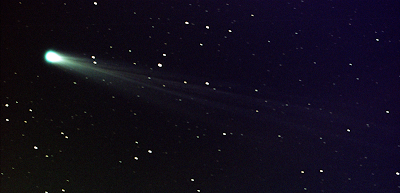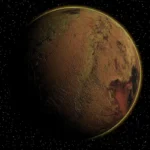
A comet is a very small solar system body made mostly of ices mixed with smaller amounts of dust and rock.
Comets orbit the Sun in an oval pattern.
“Comet” comes from the Latin “cometes”, which in turn comes from the Greek “kometes”, meaning “long-haired”.
Comets are made in the Kuiper Belt and the Oort Cloud.
A comet has four components: a nucleus, a coma, a dust tail and an ion tail.
Usually comets remain in the outer edges of the Solar System until they bump into each other changing their direction.
The nucleus of a comet is composed of ice and rocky material and it ranges from about few hundred meters to 100 km ( 62 miles) in diameter.
Comets only have tails when they are melting.
The cloud of gases that forms around the nucleus as the coma is heated is know as the coma. These gases are usually a mixture of water vapor, ammonia, carbon dioxide.
Comets can be up to 40 kilometers across.
The dust tail of a comet is composed of gases and tiny dust particles blown away from the nucelus as the comet is heated. The dust tail is the most visible part of a comet.
Haley’s Comet, the most well-known comet, appears once every 76 years.
The ion tail is a stream of ionized gases that are blown directly away from the Sun as a result of the
comet’s contact with the solar wind.
Comets that orbit less than 200 years are referred to as short term comets.
When a comet is heated by the Sun, its ices begin to sublimate. The mixture of ice crystals and dust blows away from the comet nucleus in the solar wind, creating a pair of tails. The dust tail is what we normally see when we view comets from Earth.
Haley’s Comet is an example of a short term comet.
Comet tails can be over 1 million km (600,000 miles) long.
The next appearance of Haley’s Comet is expected to occur sometime in the year 2061.
Gas and water make up about 70% of a comet.
Comets come in several categories. The most common are periodic and non-periodic.
Comet Shoemaker-Levy 9 is another known comet that collided with Jupiter in 1994.
Periodic comets or short-period comets are generally defined as having orbital periods of less than 200 years.
Small comets are about 1 kilometer across.
Well-known comets include the non-periodic comets Hale-Bopp (C/1995 O1), Hyakutake (C/1996 B2), McNaught (C2006 P1), and Lovejoy (C/2011 W3). These flared brightly in our skies and then faded into obscurity.
Most comets are too small and too far away to be detected from Earth.
In addition, Comet Shoemaker-Levy 9 (D/1993 F2) was spotted after it had broken up after a close call with Jupiter.
The periodic Comet Halley (1P/Halley) is the most famous in history. It returns to the inner solar system once every 76 years. Other well-known periodic comets include 2P/Encke, which appears ever 3.3 years and 9P/Tempel (Tempel 2), which was visited by the Deep Impact and Stardust probes, and makes perihelion around the Sun every 5.5 years.
In 1705, while studying the orbits of several known comets, Edmond Halley found that the comet observed in 1531, 1607 and 1682 was one in the same. As a result of Halley’s discovery, the comet was named after him. Halley’s Comet is visible every 75 to 76 years.
The orbital times for comets can range from several years to millions of years.
While the coma over Halley’s Comet can stretch up to 100,000 km across, the nucleus is actually small, only around 15 km (9.3 miles) long, 8 km (5 miles) wide and 8 km (5 miles) thick.
Comet Hale–Bopp was perhaps the most widely observed comet of the 20th century and one of the brightest seen for many decades. It was discovered on July 23, 1995, at a great distance from the Sun, raising expectations that the comet would brighten considerably by the time it passed close to Earth. It was visible to the naked eye for a record 18 months, twice as long as the previous record holder, the Great Comet of 1811.
About 30% of a comet is made up of metals.
Comets orbit the Sun in elliptical paths – just like the planets. The path of a comet though is far more elliptical than that of any planet.
The closest point in a comet’s orbit to the Sun is called “perihelion”. The most distant point is called “aphelion”.
Comets have two tails: a dust tail (which you can see with the naked eye) and a plasma tail, which is easily photographed but difficult to see with your eyes.
Sometimes comets are referred to as “dirty snowballs” or “cosmic snowballs”. This is because they are composed mostly of ice, rock, gas and dust.
There are over 3,000 currently known comets.









